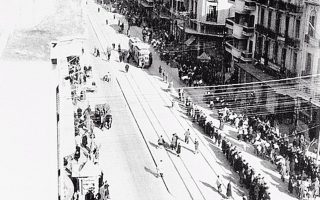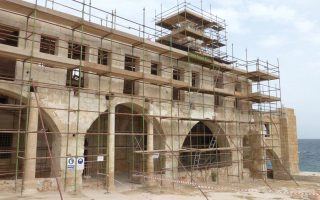Zakynthos wreck, a famous island landmark, to be restored

It is one of the most photographed spots in Greece and a symbol of the Ionian island of Zakynthos that features on myriad publicity posters. Yet the shipwreck on the beach that is now better known by that name (Navagio meaning shipwreck in Greek) has suffered extensive wear and tear in the 36 years it has lain on one of the most beautiful seashores in the country. Acknowledging its significance not just as a tourist attraction but also as a globally recognizable landmark, the island’s municipal authority has teamed up with the local technical college to launch the first restoration of the wreck so that it can survive for more generations to come.
The ship is the Panagiotis, which set sail in October 1980 from Albania for Piraeus but was prevented from reaching its destination after bad weather forced it ashore at Aghios Georgios. The island’s residents at the time were up in arms about the environmental and aesthetic effects of the wreck lying on one of its most pristine beaches, yet it was impossible to move for a number of different reasons, so the Panagiotis remained right in the same spot where it washed up.
The accident, however, was a blessing in disguise as the view of the wild natural surroundings of this still-hard-to-access beach and the wreck lying on its side in the sand have created a unique setting that soon made its way around the world in snapshots and became synonymous with Zakynthos.
However, in the 36 years that have elapsed, erosion has taken its toll.
“We can’t allow the shipwreck to be destroyed. It’s a symbol of Greece, recognized worldwide,” says Zakynthos Mayor Pavlos Kolokotsas, who joined forces with the Department of Cultural Heritage at the Zakynthos-based Technical College of the Ionian Islands.
The first step, according to the head of the municipality’s Tourism Committee, Antonis Nikoloudakis, is to visit the wreck and document the extent of the damage.
“We will also take certain protective measures this year,” he says. “The area will be fenced off with a barrier that will prevent people from approaching the wreck but will be discreet enough so as not to upset its aesthetic appeal for those who want to be photographed beside it. We will also place a sign with the wreck history, as well as assigning a lifeguard and a guard at the beach so we can bring some order to the situation.”
Christos Karydis, a professor at the technical college, confirms that experts still do not know the extent of the damage the wreck has suffered.
“We will start by identifying the materials it consists of and then we will deliberate on how we will proceed, firstly to improve the wreck’s stability and then to restore it.”
Funding is another hurdle that the initiative still has to overcome.
“The municipal authority will certainly contribute. We will look for sponsors and explore different ideas,” says Nikoloudakis. “The aim is for the initial study to be finished within the year and the restoration before the end of the next tourism season.”





